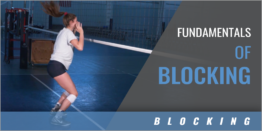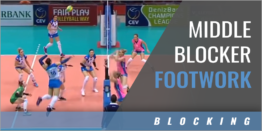Provided By: Jim Stone, Author of "A Game Plan For Better Practices"
Purchase Access to Full E-Book Here: https://jimstoneconsulting.com/book/
Watch as Coach explains how he wants the jump serve to have a rhythm to it like a spike approach. This is four-step approach with the toss on the second step. Lay the ball out in front on the toss with the arm swing similar to a spiking situation. The toss leads the server out into the court closer to the passer and contact is full arm extension. The contact is the same as a standing float with the server taking the spin off the ball with good firm contact on the equator of the ball.
Incorporating Tactics into The Serve
When a player has a solid foundation of the serve mechanics and can consistently execute the standing float serve or the jump float serve, it is time to incorporate tactics into the skill. When executed well, a strategically placed serve can lead directly to points via an ace, force the opponent out of their system, or influencing what the opponent might do offensively.
First, a review of the essential components of the standing float serve and the jump float serve. The goal of both types of float serve is to have a flat trajectory, good velocity, and impart zero spin on the ball. This type of serve has an erratic and unpredictable flight path making it challenging to pass accurately.
Standing Float Serve
- Hold the ball in the non-dominant hand, extended, in front of the hitting shoulder
- Feet are staggered with LF forward
- Assume the "T-position" with the dominant arm (see picture)
- Toss the ball in the air slightly higher than full arm extension height
- Using the same arm swing and mechanics as attacking, throw the hand up to the ball
- Contact with full arm extension with an open hand, the hand/wrist is held firm and strikes the center of the ball
- The follow-thru is limited, and palm points to the target
- The trajectory should be low with no spin on the ball
- Spin on the ball indicates 1) loose wrist; 2) contact not at the center of the ball.

Jump Float Serve
- Approach
- 4 step approach in the same sequence as the attack approach
- The toss is on 2nd step (Left Foot on the ground)
- The toss should lead the server into the court
- Armswing/Contact
- Similar to standing float serve
- T-position
- Contact at close to full extension
- Firm wrist and hand
- Contact at the center of the ball
- Limited Follow-Thru
- Finish palm to target
The criteria that I have for skill competency for both styles of float serve is:
- A firm and clean hand/ball contact imparting no spin on the ball
- The ability to serve a ball with a flat trajectory
- Impart good velocity on the ball (35-38 mph)
- Can direct the ball accurately to specific areas of the court
When the server can perform at this level, they are ready to use tactics to weaponize the serve. The goal of the serve is not to serve aces. Of course, we take aces as they come. However, if the goal is to serve aces, the potential for service errors is increased. The primary goal of the serve is to get the receiving team "out of system." When a team is out of system, their ability to run an effective sideout offense is diminished.
As we explore tactics, I will refer to zones of the court for both passer and server.
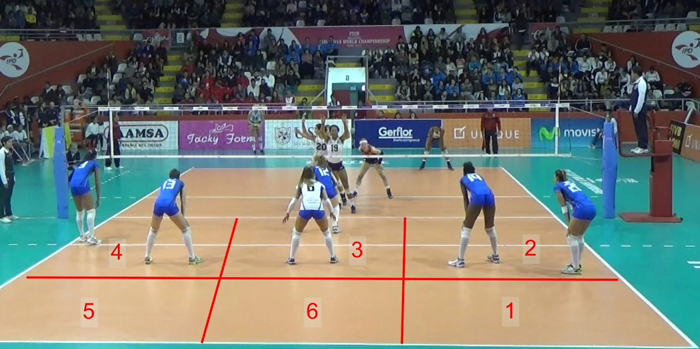
For example, if a server is standing in RB to serve, they are in Zone 1. If the passer is in the middle back area, that is Zone 6.
The first part of serve tactics is where the server positions themselves along the end line. If you look at the three diagrams below, you will see the results of over three thousand serve and serve-reception attempts at the national team level. The serve position was evaluated based on the quality of pass (4.0 scale) and the sideout percentage.
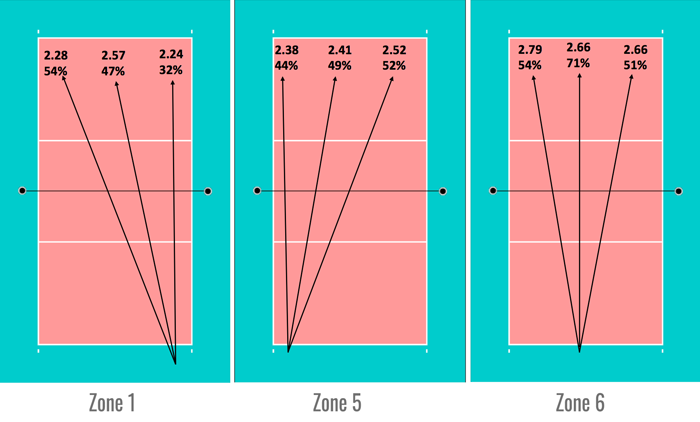
As you can see, the most effective serve from Zone 1 was going to area 5 on the opponent's court (32% sideout percentage; 2.24 reception score). Proceeding to Zone 5 and Zone 6, you can make a couple of observations. When the server is initiating the serve from Zones 1 or 5, the most effective serve is down the line to Zones 5 and 1, respectively. That is also a serve with risk as the server aims for a small portion of the court.
The least effective area to initiate the serve is Zone 6. The opponent's reception and sideout scores are the highest when the serve is coming from Zone 6. The takeaway from this information is to encourage your servers to serve from corners (Zone 1 and 5) to the corners of the opponent's court. The advantage of serving crosscourt (Zone 1 to Zone 1) is the distance is greater, so the server can hit the ball with more velocity.
As you can see from the Heat Map, most of the serves at the FIVB U-18 World Championships will go deep and to the corners of the opponent's court.

The second picture tracks the serve pattern by Japan in a match against Brazil. The obvious strategy was to serve the LF hitter deep to the corner of Zone 5 with the intent of impacting their ability to be an effective attacker.
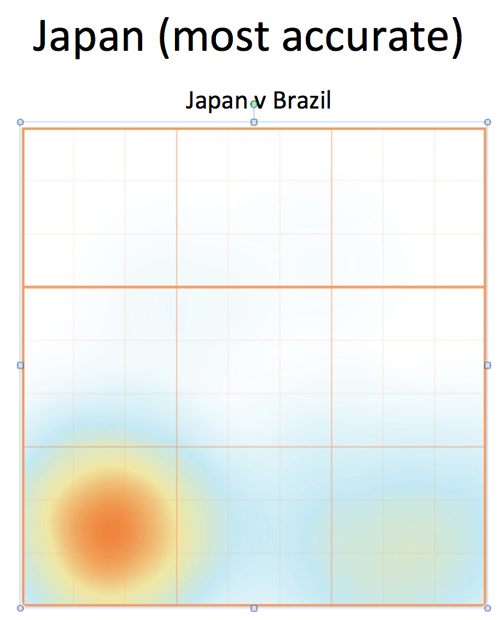
Work with your athletes on locating their serve in the last three feet of the opponent's court. A deep target area allows the server to impart good velocity on the serve.
Short Serve
In some situations, serving the short area (Zones 2, 3, and 4) is an excellent tactical serve. In general, a short serve should have a similar trajectory as a deep serve. If serving short, the server should stand in a location, so the serve is in the air for the shortest possible time. For example, if serving short to Zone 4, the server should stand in Zone 1. A short serve that travels crosscourt will be in the air longer (greater distance), allowing the passers to react.
There are a couple of reasons for a short serve.
- A short serve to the middle attacker might impact the quick offensive options.
- If the team reception pattern drops deep, a short serve might exploit the open court.
- A short serve to an outside hitter might impact the quality of the spike approach.
- A short serve to Zone 2 might impact a middle hitter who wants to attack behind the setter.
Below I've listed several other considerations when using the serve as a tactical weapon:
- Serve the opponent's best or most effective attacker. Often, a hitter's effectiveness is reduced when they are forced to pass in advance of hitting.
- If the opponent has an effective backrow attack, place the serve in the backrow attacker's area.
- If a serve brings a hitter/passer towards the middle of the court, it might impact their ability to attack crosscourt at the net.
- Serve in the area of the player who has just made an error.
Make sure the error percentage for the serve is low. For the USA U-18 team, the ball was served in-bounds 93% of the time. We wanted consistent contact, speed, and location. I would encourage coaches to incorporate tactics into the skill of the serve. If the efficiency of the sideout offense can be impacted by strategic serving, then the server has done their job.



